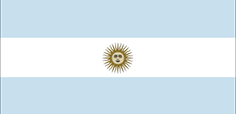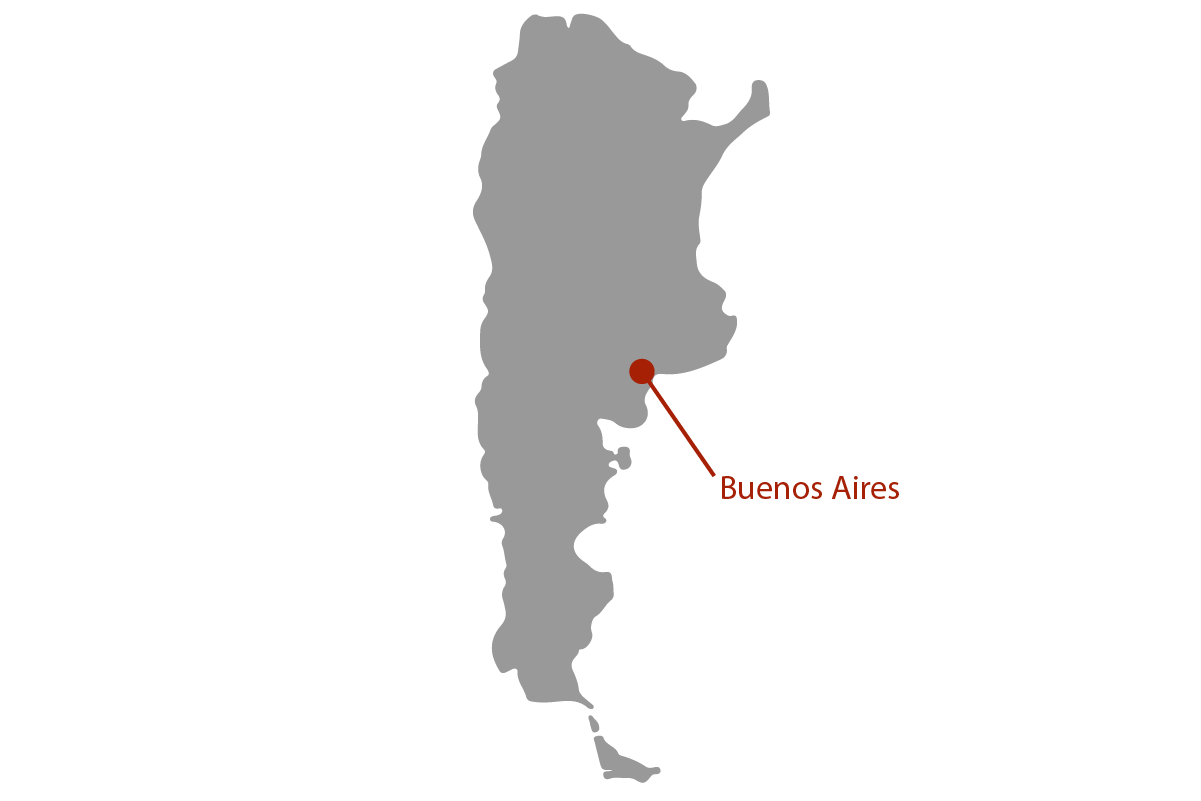Argentina Key Facts
-
Flag


-
Size
2, 780, 400 km²
8th largest -
Population
42, 669, 500
-
Argentina Location
South America
-
Travel Insurance
For Argentina travel insurance, select Worldwide Region
-
International Calling Codes
54
-
Cities
Mendoza
Salta
Ushuaia -
Language
Spanish
-
Religions
76.5% Catholic
11.3% Agnostic and Atheist
9% Evangelical Protestants
1,2% Jehova's Witnesses
0,9% Mormon
1,2% other religions (including Islam, Buddhism and Judaism)
-
Currency
-
Driving
In Argentina they drive on the right side of the road
Tourism website:
southamericatourism.com
When is the best time to visit?
Due to its size, Argentina is home to many different climatic regions. Generally, spring (September-November) is ideal for most regions. The best time to visit Tiera del Fuego is summer (December-February). Autumn (March to April) is the time for wine harvests in Cuyo; Patagonia and Tierra del Fuego offer stunning sceneries that time of year. Winter (June to August)is the time for skiing in Andean resorts.
Transport Information
Rail, 161 airports with paved runways (more than a thousand without), 19 international airports, bus, highways, ports and harbours.
World Heritage Sites
- Iguazu National Park, home to the 80m high waterfalls that measure 2,700m in diameter
- Ischigualasto/Talampaya Natural Parks, two parks extending over 275,300ha of desert that contain the fossil record of the Triassic Period
- Los Glaciares National Park, home to numerous glaciers, towering mountains and stunning glacial lakes
- Península Valdés, the breeding grounds of the endangered southern right whales, southern elephant seals and southern sea lions.
- Cueva de las Manos, Rio Pinturas, represents an outstanding collection of cave art made between 13,000 and 9,500 years ago
- Jesuit Block and Estancias of Córdoba, the heart of the former Jesuit Province of Paraguay
- Jesuit Missions of the Guaranis, shared between Brazil and Argentina in the heart of a tropical forest are the remaining ruins of five Jesuit missions building during the 17th and 18th century
- Qhapaq Ñan, Andean Road System built by the Incans this system covers 30,000kms linking the Andes to the coast
- Quebrada de Humahuaca, a narrow and mountainous valley along the Inca Trail showing substantial evidence of human use dating back 10,000 years
-
Average Annual Temperature
Average temperatures depend on the region, ranging from 24 degrees in Buenos Aires to 11 degrees in Córdoba. Further south the weather becomes colder.
-
Average Annual Rainfall
Approximately 1000 mm per year in Buenos Aires
Less than 500mm in Mendoza.
Climate Information
The Pampas are generally temperate with cold winters and hot and humid summers. The Andes in the north are cool in summer and very cold in winter. Patagonia in the south is also cool in summer and extremely cold in winter. Cuyo offers extremely hot summers and cold and dry winters.
Official Holidays
- January 1 - New Year's Day
- March 24 - Day of Remembrance for Truth and Justice
- Aprils 2 - Day of the Veterans and Fallen of the Malvian War
- March/April - Good Friday
- May 1 - Labor Day
- May 25 - National Day
- June 20 - National Flag Day
- July 9 - Independence Day
- August 17 - San Martín Day
- October 12 - Day of Respect for Cultural Diversity
- November 20 - Day of National Sovereignty
- December 8 - Immaculate Conception
- December 24 - Christmas Eve (begins midday)
- December 25 - Christmas Day
- December 31 - New Years Eve (begins midday)
Why Visit Argentina?
Argentina holds a multitude of attractions: spectacular natural wonders from Patagonia to the Andes, the bustling metropolis of Buenos Aires, delicious culinary traditions, great wines, and many opportunities for adventure seekers to explore and discover.
Things To Do In Argentina
- Skiing in the Andes
- Wine Tours through Mendoza and Salta
- UNESCO World Heritage sites
- Quebrada de Humahuaca in the far north-west, Tierra del Fuego
Travel Tips For Argentina
- Expect a relaxed attitude towards time and punctuality everywhere! Whether meeting someone, going to a concert or taking a bus, expect a late start.
- Take the opportunity to visit a local institute for Spanish or Tango lessons - education in Argentina has very good quality.
Argentinian Food
Argentinian beef is world-famous and forms an important part of their diet. It can be found everywhere from barbecues (asados) to street-side vendors. Another popular item on the menus are empanadas, which are baked pastries with meat or vegetable filling. Due to the large portion of Italian, French and Spanish descendants, high quality Pizzerias and specialty ethnic restaurants are ubiquitous. Pizzas in Argentina tend to have a thicker base and places more focus on the cheese. It is also important to note that pasta and sauce are sold separately! Bakeries and ice-cream shops (heladerias) are also very popular for a quick snack or even a home delivered ice-cream.
Argentina Travel Safety and Warnings
- Be aware that traffic mortality rates in Argentina are the highest in South America with an average of 20 deaths each day.
- Avoid wearing British/English symbols or soccer jerseys.
- In bigger cities, avoid flashing cameras or expensive equipment. Generally Buenos Aires is safe, but be wary of pickpockets.
- Good travel insurance for Argentina is recommended.
About Argentina
When most people think of Argentina, two things immediately pop into their minds: soccer and tango! Certainly Argentina is a soccer mad country, and it is also home to the tango, but these two words do not even come close to summing up this stunning country. Argentina has 9 UNESCO World Heritage Sites, offers spectacular nature vistas, it is a foodie's heaven, and has some of the wildest and most expansive terrain on the planet. But, before setting off on any explorations in this vast and rugged country, make sure you have the right gear and travel insurance!
Being the 8th largest country in the world, the countryside changes drastically from the North to the South. The northern regions of the Andean Northwest and Chaco bear a strong resemblance to neighboring Peru and Bolivia. If you want to go where the locals go and get away from international tourists, this is the place. Coming here you see amazing vistas of the Andean mountains, you can pet a llama and get to try some locro: a hearty stew made from locally grown corn, pork meat and pumpkin that will warm you on cold nights.
Neighbouring Chaco is the region of Mesopotamia, home to the world famous Iguazú Falls and a UNESCO World Heritage Site. Words can truly not adequately describe what it is like standing in this 13,000km2 nature reserve, looking at the dramatic waterfalls that are taller and twice as wide as Niagara Falls. Surrounding the falls is a spectacular rain forest. This area is accessible from both the Argentinian and the Brazilian side. Do take the time to explore this landmark from both sides if you have the opportunity!
Buenos Aires, which is situated in the Pampas region, is where most travellers will arrive. This bustling city consists of 48 different districts. Most tourism tends to center around La Boca, a wonderfully colorful neighborhood with a good vibe. Walking around here you will discover the Caminito ('little path') a pedestrian street filled with local arts and crafts. In the North of Buenos Aires you will find the Recoleta neighborhood, which is home to embassies, fancy hotels and the cemetery that has become the resting place of the national icon Eva Peron. If you happen to be in Buenos Aires on a Sunday, make sure to visit the street and flea market in San Telmo. If you stay until the evening, you may also catch one of the live tango performances.
West of Buenos Aires and the Papas is the Cuyo region, which is boasts to have Argentina’s finest wines. It also hosts the highest mountain in the chain of the Andes: Aconcagua, which is also the highest peak outside of Asia. 80% of the wine produced in Argentina comes from this region, making it ideal for budding wine connoisseurs. Should you be inclined to study español, Mendoza is home to several excellent Spanish… what? schools, classes etc
South of Cuyo and the Pampas you find Patagonia and the famous Tierra del Fuego. Patagonia is at the same time stunningly beautiful as it is utterly desolate. This region is raw and un-spoilt offering nature tourism at its finest. This area is particularly popular among mountaineers, wishing to climb virgin peaks, and motorcycle riders doing big tours. If you want to go exploring in Patagonia, you will need a bit more than good travel insurance and a headlamp, good preparation is key.
The southern most tip of Patagonia is Tierra del Fuego. Separated from the mainland of Argentina by the Magellan straight. Half of this magnificent land belongs to Argentina, the other half belongs to Chile. This area is usually sought out by adventure travellers wishing to go Kayaking in the Beagle Channel or hiking along trails in the national park or up a glacier. Make sure to try some of the local specialty: King Crab ('centolla').
While Buenos Aires offers the city experience replete with clubs, tango lessons, and museums, seeing the rest of Argentina can be a bit trickier and requires adequate planning. Bus and airplanes are very valid options for getting around, but they can be expensive. Cheaper options are available in the form of trains or flying LADE (a local airline), but they tend to favor locals over international travellers. As a general precaution for travelling in South America take out good travel insurance.
Argentinian time and actual timetables are also often at odds with each other, whether it be a concert or a flight. Whatever you have planned will probably happen just a little bit later. In bigger cities beware of pickpockets operating alone and in groups.


